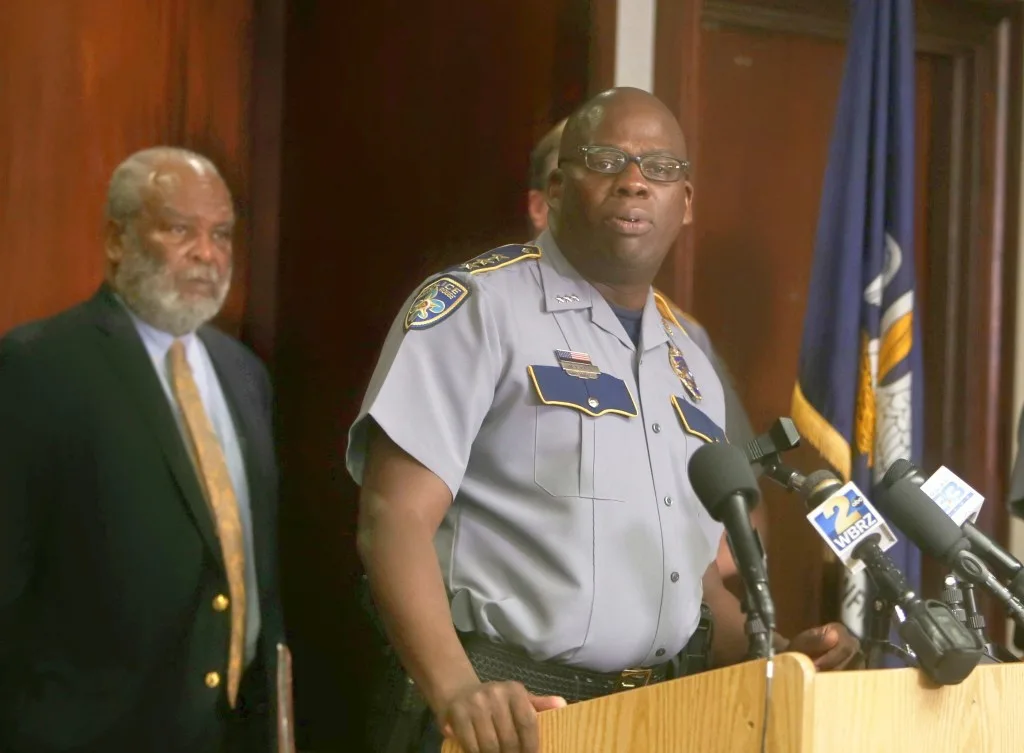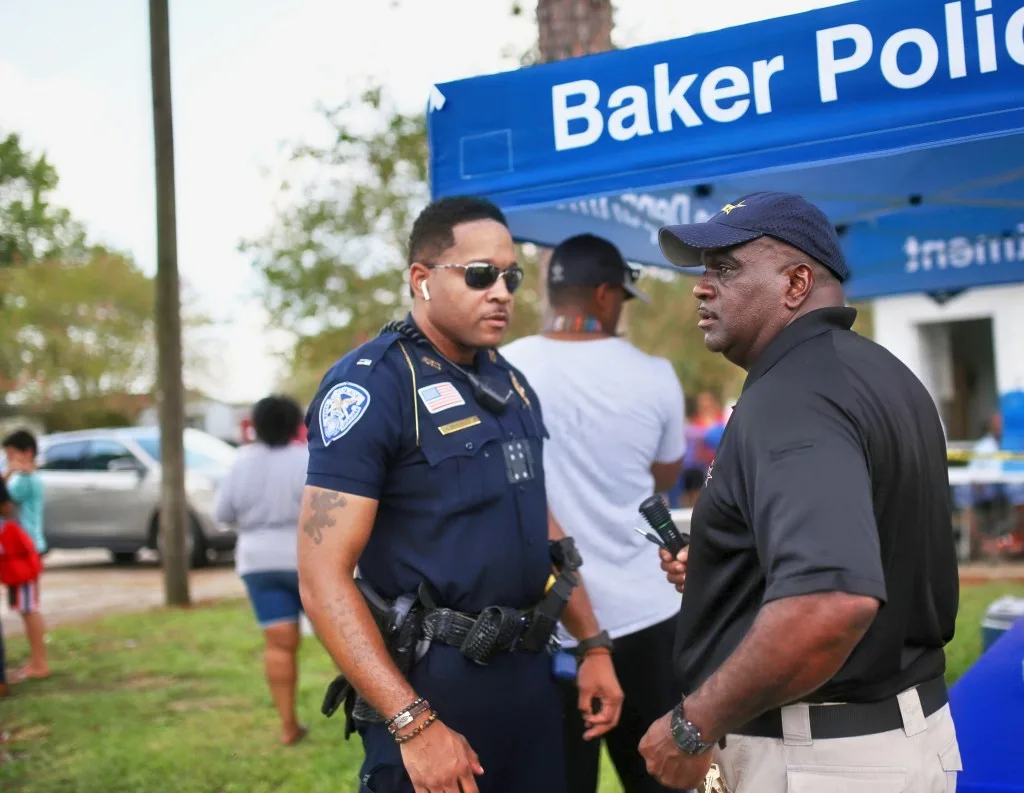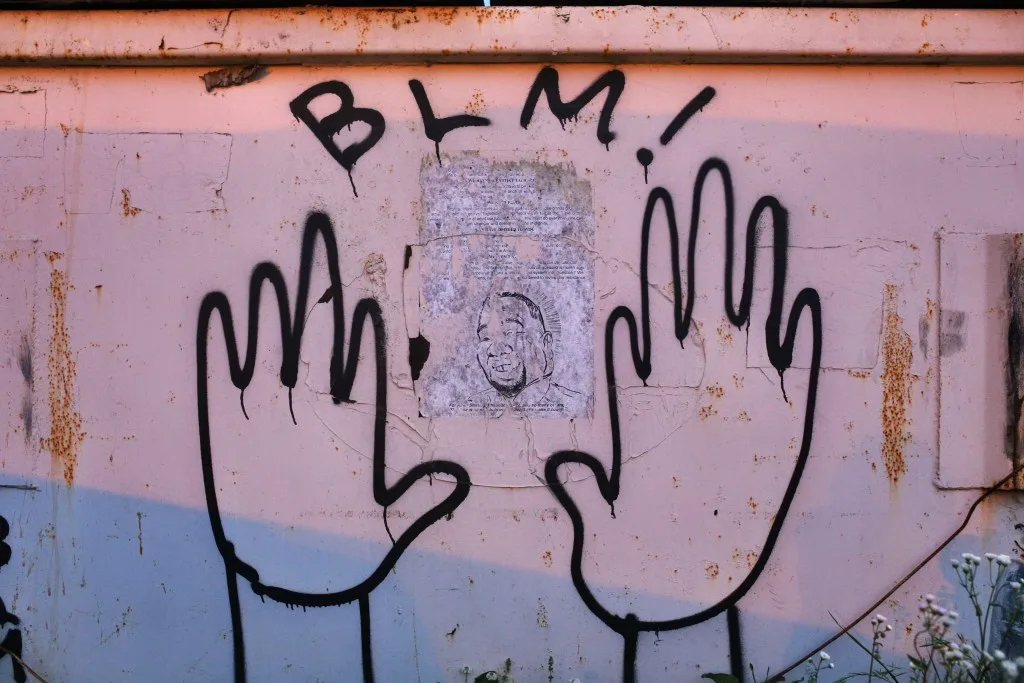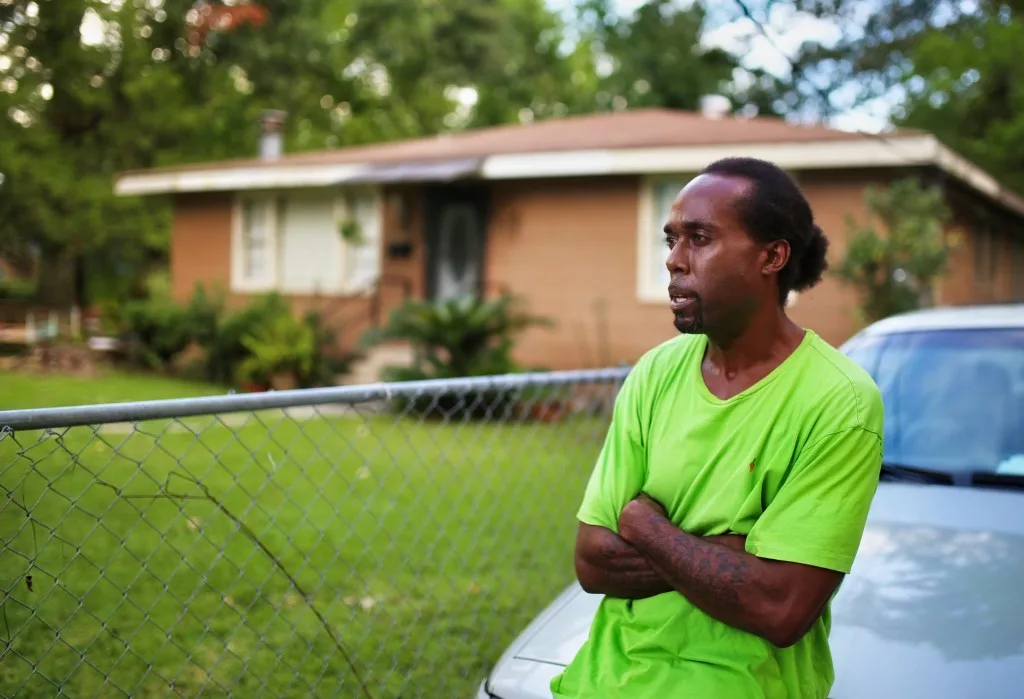This article first appeared on Verite News
A man sold CDs at a table outside the Triple S Food Mart in Baton Rouge as customers ambled in and out of the convenience store.
A few women showed up in the parking lot for a protest that never materialized. Passing cars occasionally gave an encouraging honk in support of those seeking justice for Alton Sterling.
A 10-minute drive away, new Baton Rouge Police Chief Murphy Paul sat in his office at BRPD headquarters with a different scene of the Triple S on his mind.
About two years earlier, just after midnight on July 5, 2016, Baton Rouge police had rolled up on the store after an anonymous report of a man threatening people with a gun. The two officers – Blane Salamoni and Howie Lake II – confronted the 37-year-old Sterling, the CD salesman behind the table that night.
Salamoni pulled his gun almost as soon as he arrived and the situation quickly escalated when Sterling didn’t cooperate. It ended with Salamoni firing six shots into Sterling as the officers had him pinned to the ground.
The fatal shooting, which was caught on camera and shared widely on social media, set off widespread street protests and mass arrests.
Less than two weeks later a gunman, in an attempt to get revenge for Sterling’s death, shot and killed three law enforcement officers, and injured three others in Baton Rouge, one of whom succumbed to his injuries years later.
Still reeling from the summer shootings, the city was inundated in August by historic floods that damaged thousands of homes and businesses and disrupted lives.
And now, in late March 2018, not quite three months into his new job as chief, Paul had to decide whether to fire Salamoni.
Earlier that day, Louisiana Attorney General – now front-running gubernatorial candidate — Jeff Landry had announced that there would be no state criminal prosecution in the case. The U.S. Department of Justice had already declined to seek federal charges.
All eyes were now on Paul, a decorated retired Louisiana State Police deputy superintendent with more than a quarter of a century of law enforcement experience under his belt.
A couple of days later he scheduled a press conference. He didn’t reveal his decision until moments before going out to face the cameras. He phoned the mayor to let her know his decision and then stepped out into the chief’s conference room where reporters were waiting.

He was terminating Salamoni for violating “use of force” and “command of temper” policies. It was a decision that “was not based on politics, it was not based on emotions,” he said.
“These actions were not minor deviations from policy as they contributed to the outcome that resulted in the death of another human being,” Paul said. “Fear cannot be a driver for an officer’s response to every incident. Unreasonable fear within an officer is dangerous.”
The decision shouldn’t have come as a surprise to the department’s rank and file. When he came into the job, Paul was explicit about his mission: to institute new standards of professionalism and accountability in a police department often seen as lacking both.
But it would spark a civil war between the new chief and an entrenched old guard at the BRPD that would be waged on the street and in City Hall, in boardrooms and online chat rooms. It even pitted officers and administrators within the police department against each other.
A ‘George Floyd moment’
Louisiana’s capital city had its “George Floyd moment” – social media scrutiny, mass protests and violence – nearly four years before Floyd died at the hands of Minneapolis police.
The war playing out in Baton Rouge raises questions about whether the momentum for police reform that ignited after the deaths of Sterling, Floyd and others can overcome the historical, political, bureaucratic and ideological barriers that shield officers from accountability.
There have been tooth-and-nail battles over minor disciplinary issues, police union opposition, marathon civil service hearings, death threats to Paul and his family and even an alleged plot to set up the chief for a DWI arrest.
When Paul announced his retirement in mid-July after five and a half years of service to the city, he seemed to have succeeded more in winning over segments of the public than in changing the department culture.
People close to Paul said that it wasn’t until after the Salamoni announcement that he realized the scale of the resistance he was going to face trying to change the culture within the department.

“I talked to him at his lowest,” said Carl Dunn, a retired BRPD deputy chief, who left the department before Paul arrived. “And he told me, ‘I can’t even rest when I’m away from that place. I can’t rest. It’s just too much.’”
How far he has gotten in changing the department remains to be seen.
Even Paul’s retirement letter to Mayor-President Sharon Weston Broome leaves the question open.
“Mayor President, the foundation of the Baton Rouge Police Department is firm. I would not retire if I did not believe this to be true,” he wrote.
But a few sentences later, he expressed some doubt.
“I was in conflict with this decision,” he wrote. “Part of me feels that we still have more work to do.”
In the end of August, about a month after his retirement announcement, the department became embroiled in another controversy: A federal lawsuit alleging that a BRPD garage nicknamed the “BRAVE Cave” was being used by officers to detain, strip-search and interrogate suspects without warrants or probable cause.
In a recent Metro Council meeting Paul said he called in the FBI to ensure that the investigation of the BRAVE Cave allegations will remain independent when he retires. He also encouraged residents to contact the FBI directly if they don’t feel comfortable going to the BRPD.
Paul has said he knew of the garage but was not aware of the nickname or that the facility was being used in the way that is being alleged. The Street Crimes Unit, which used the facility as a “narcotics processing center,” has been disbanded.
BRAVE, for Baton Rouge Area Violence Elimination, is a reference to a program designed under a previous chief, DeWayne White, as a tool for outreach for at-risk youths. In its early days it was successful. The program then became a boondoggle for what mutated into the Street Crimes Unit under White’s successor, Chief Carl Dabadie.
The scandal has turned conservative defenders of the status quo and progressive activists calling for police reforms into allies. Republicans who previously blocked funding to support Paul’s disciplinary efforts and who receive police union support called for Paul’s removal before his resignation takes effect in November.
Meanwhile, Paul’s defenders have pointed to Sterling’s death as one of many examples of police misconduct that went ignored or rewarded for decades before the new chief arrived.
Under previous administrations, the public would have waited for years for action to be taken – if at all, Paul’s supporters say. The “BRAVE Cave” scandal is part of the very system that Paul has tried to reform in his tenure – a result of unfinished business, not of his policies.
The Baton Rouge Police Department did not respond to requests for further comment for this story and former Chief Carl Dabadie, now a major in the East Baton Rouge Sheriff’s Office, could not be reached.
Paul took the BRPD job in early 2018 with a stated goal of making the department more accountable to the public.
According to sources familiar with the Salamoni decision, he immediately dived personally into the Sterling shooting case, examining body camera and security footage and reviewing eyewitness testimony and interviews with both of the officers who responded to the scene.
Paul believed Salamoni’s firing was appropriate, but instead of being the final word it set off a months-long procedural battle.
Blane did not want to shoot this guy. Trust me. He only did it when he pulled that gun out. People just don’t want to listen to that fact.
– John McLindon, Blane Salamoni’s attorney
John McLindon, Salamoni’s attorney during the administrative battle with Paul, said that the former officer wants to put that chapter of his life behind him and would rather not comment on this story.
He said he strongly disagreed with Paul’s decision to fire Salamoni, and that both federal and state experts said that Salamoni’s use of force was justified.
“I really don’t know what Chief Paul’s grounds were to terminate Blane Salamoni,” he said. “I know what they were but they certainly weren’t supported by anybody but himself.”
Salamoni, he said, was just trying to get Sterling under control.
“Blane did not want to shoot this guy. Trust me. He only did it when he pulled that gun out. People just don’t want to listen to that fact,” McLindon said.
It did not surprise him that “it would get so ugly,” he said, between the chief and his officers over the years. He has followed what he described as the “acrimonious” battles in the Municipal Fire and Police Civil Service Board in local media.
“He is the most divisive chief we have ever had,” he said. “I don’t ever remember having a chief that caused so much animosity and acrimony as he has.”
McLindon said he sympathizes with the African American community in Baton Rouge. He doesn’t doubt that they were the victims of racial profiling over the years.

“I’m sure most African Americans were saying, ‘Here we go again, another black guy shot by a cop,’” he said. “I totally get that, that they would think that.”
But he said he thinks anyone who examines the case will see that the Sterling shooting was clean.
“When you dig deeper into the details, you say, ‘Well, you know what, that was justified. Maybe Alton should’ve just put his hands on the car,’” he said. “The reason he couldn’t is because he knew he was a convicted felon, and he knew by having that gun on him he was going to go to jail.”
Salamoni appealed his termination with the Municipal Fire and Police Civil Service Board, which included a police officer with a record of consistently voting to overturn proposed disciplinary measures and putting accused police officers back on duty –– something Paul wanted to avoid with Salamoni.
So, while Paul’s administration fought with union lawyers behind the scenes, hearings before the board were postponed over and over.
After about a year and a half of clashing, the two sides reached an agreement. In August 2019, Paul again called a press conference – this time to announce a deal in which Salamoni would be rehired and then allowed to resign.
Without the deal, Paul feared that Salamoni could have won his appeal to the civil service board and wound up back in a BRPD uniform. Paul said he didn’t want to take that risk.
“I think that we have to be honest when we try to understand the history of policing in the city of Baton Rouge,” Paul said at a press conference in August 2019 during which he apologized to Baton Rouge that Salamoni was ever hired by the department in the first place. “We must recognize and acknowledge that some of our policing practices have traumatized parts of our community. This is bigger than Alton Sterling. That was just the tipping point for some in this community.”
Because of the settlement, Salamoni can continue to work in law enforcement in Louisiana but is not currently doing so.
A dog and pony show down in the muck
While Paul’s comments may have reassured some residents who had suffered at the hands of the BRPD, the remarks did not sit well with some in the rank and file who were accustomed to chiefs consistently backing their officers.
The appeals, delays and negotiations that played out with Salamoni were part of a strategy that Paul would encounter as he disciplined other officers and met resistance in his efforts to change the department’s culture.
“Before Murphy Paul, the running joke — all over the state of Louisiana — was that the Baton Rouge Police Department didn’t have an Internal Affairs,” said Dunn, who is now police chief in the nearby city of Baker.
That’s why Dunn didn’t hesitate when he was asked about Paul’s legacy.
“The most important thing Chief Paul did was clean up Internal Affairs,” he said. “It didn’t exist before him. There was no accountability, none.”
Former NAACP Baton Rouge President Eugene Collins, a vocal opponent of police abuse in southern Louisiana, agreed. He described the previous disciplinary and investigatory process as a “dog-and-pony show.”
A previous investigation by Verite News found that between 2009 and 2018, Internal Affairs ruled 86% of the 308 use-of-force complaints investigated as “exonerated” or “not sustained.” In 2017, the year after Sterling was killed, that number rose to 100%, according to the department’s data.
“These hearings were designed to get bad officers back on the force. They would always deliberately do something ‘wrong’ [in the investigative or administrative process] so they would always get off without any punishment. The first time we saw the accountability was with Murphy,” he said, referring to Chief Paul.
“Baton Rouge is a mucky place, man,” he said. “And you don’t realize it until the muck reaches out and touches you.”
GET THE MORNING HEADLINES DELIVERED TO YOUR INBOX
For insiders, the decision to clean up and fortify the division responsible for investigating bad behavior may have seemed revolutionary. But to citizens following the news, the changes mostly seemed to bring headlines about delays, appeals and bureaucratic infighting.
But the coverage about bureaucratic processes and contentious public hearings masked the underlying battle for the soul of the department and the incredible resistance to change that was mounted from within.
Paul was warned about threats against his life and began wearing a bulletproof vest to public appearances. He thought it safest for his family to live in a gated community outside of Baton Rouge. One of his opponents shared a picture of Paul’s teen sons at a local fair taken on a family trip and suggested that they were “throwing gang signs.”
Paul, the second Black chief in BRPD history, had no clue how deeply ingrained racism was in the department, said Dunn, who was the department’s first Black commander of Uniformed Patrol from 2013 until his retirement in 2015. He recalled Paul saying that he needed to “24/7 have eyes behind my head and a bulletproof vest on my back.”
But for all the challenges, Paul still managed to institute significant changes.
He successfully lobbied state legislators to rewrite the rules around conflict of interest with members on the Municipal Fire and Police Civil Service Board. That meant appointees could no longer have close formal ties to labor if they were going to sit on the board.
He stood up to leaders in the police union, who in the past had friendly relations with mayor-presidents, saying publicly that he wouldn’t be “bullied” by people in the department challenging his authority.
Some officers who tried to thwart his efforts were investigated for violating policy and were either suspended, fired or ended up resigning out of frustration.
He was within that system doing his job the right way. Let’s be honest about it, right. He just did his job. And that’s paramount in a place where people didn’t for a long time.
– Eugene Collins, former NAACP president
“The thing that we’ve never had is somebody inside of the system looking out for us,” Collins, the former NAACP president, said. “And I think that’s probably what made him so fearful to some of those folks over there. He was within that system doing his job the right way. Let’s be honest about it, right. He just did his job. And that’s paramount in a place where people didn’t for a long time.”
Paul changed the department’s body-camera policy. This included creating a video release policy that requires the department to decide whether to release footage to the public within 12 days of a critical incident when use of force results in serious injury or death.
He also pioneered an early intervention system in which officers flagged for misbehaving with the public were monitored, including through regular audits of their body camera footage.
He disbanded the department’s notorious narcotics unit. Members of the unit had been accused of “snapping,” stopping residents without probable cause and roughing them up. Others in the unit are currently awaiting trial for stealing drugs and money from drug dealers and either keeping it or selling it themselves.
Despite moving the complaint process online and making it easier to file, Internal Affairs complaints dropped under Paul. According to numbers reported in April, the department had a 40% decrease in use-of-force complaints in the past five years and a 50% decrease in Internal Affairs complaints overall in the same time frame.
And while cities around the country were having boisterous fights – both in the streets and in city halls – about police reform, Paul – eventually – was seen as a champion by many in the Baton Rouge Black political leadership and in the civil rights community. In April, he was given the “Man of the Year” award by the local chapter of the NAACP, the first time in the history of the organization that the award was ever given to a law enforcement officer.
Kiley Clifton, an activist born and raised in North Baton Rouge who hosts a popular local podcast and Instagram account under the name Johnnie Domino, grew up in and out of jail.
Before he quit street life, he was a drug dealer. He grew up resenting the police. He said he saw firsthand how crooked the police could be, not just with him, but with citizens who “lived clean.” At first, he said, he thought Paul was a puppet placed by the city’s higher-ups.
“I thought he was the Black face they put in front of us to calm us down after Alton Sterling,” he said. “A little puppy.”
He has since apologized.
“Thank God for Murphy Paul,” Clifton said during an interview in July. “Chief Paul is the only one who goes after the white, the Black and the blue. He’ll put them all in jail. Anybody who asks I tell them, ‘Chief Paul is my hero.’”
Clifton has remained a staunch supporter of Paul throughout the “BRAVE Cave” controversy.
Other former skeptics joined that group when Paul, somber and subdued and quietly angry, apologized to the city for generations of “traumatic” and dishonorable policing during his press conference about the settlement with Salamoni.
“Baton Rouge, we are sorry,” he said. “We’re sorry for our failure not to discipline an officer who demonstrated unprofessional behavior and violated our code of conduct consistently, escalating incidents. We’re sorry, Baton Rouge.”

One of the residents impressed with Paul’s comments that day was Steve Young, a truck driver who the BRPD’s Street Crimes officers dragged off of his motorcycle, beat and tased in the winter of 2018. Even Young, who had a civil case against the BRPD pending at the time, said it moved him to hear what he thought were sincere words from Paul.
“I never thought I’d see something like that in my lifetime,” Young said.
But as many in the public began to embrace Paul’s approach, the resistance inside the department was coming to a boil.
And nowhere was the friction greater than in Paul’s push to strengthen Internal Affairs.
Paul is a self-described energy guy. He is looking for solutions. The initial impression he gives off in his office the day after the Salamoni settlement announcement is more that of a corporate CEO than that of a cliched southern police chief.
The week before his 2019 apology, Paul said he held seven disciplinary meetings for officers with six more for the coming week, four of which were pushed back because of the Salamoni press conference.
“We are holding our police officers accountable,” he said. “There’s been a lot of discipline lately. I don’t hold a press conference every time I discipline one of my officers. But I think that the community should understand that we are holding our officers accountable. We are doing our job.”
Paul said he heard grumblings and sometimes worse. When he first announced that he was going to fire Salamoni, some officers left the BPRD. Paul said he recognized that some people in the department prefer to “live in the past,” and that dragging them into the future would be challenging.
“Changing a culture takes time,” he said. “It doesn’t happen overnight.”
The new chief would learn that the hard way when less than a year into his tenure he took the unprecedented and extraordinary step: Launching an Internal Affairs investigation into his own Internal Affairs Division.
SUPPORT NEWS YOU TRUST.
This article first appeared on Verite News and is republished here under a Creative Commons license.![]()

